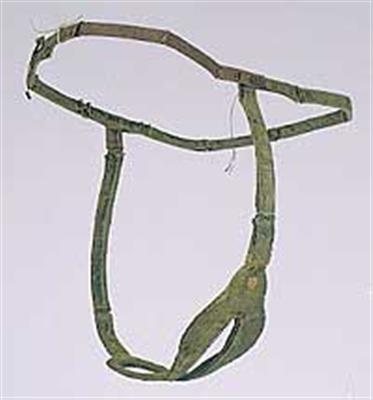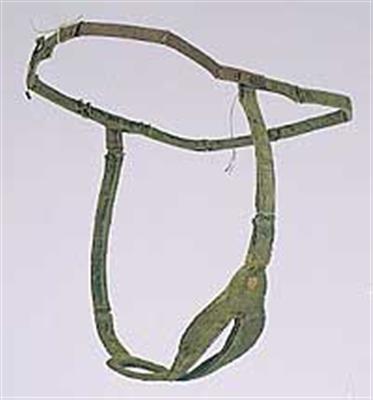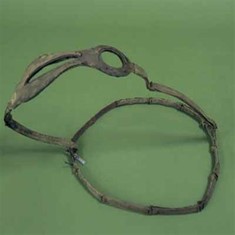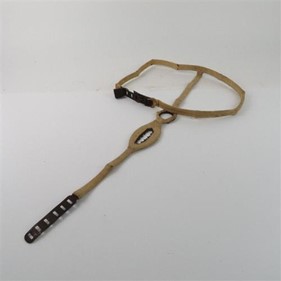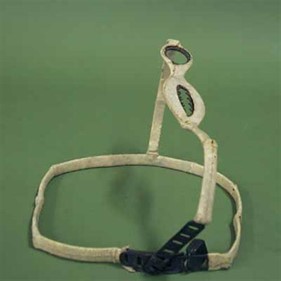What do you do when you don’t trust your partner and want to make sure they’re not cheating on you? Do you look through their phone? As those devices are relatively new, that has not always been possible. For a long time, people used other means to control their lovers, like a chastity belt. Or so we thought.
Disclaimer: this blog post uses the name Boerhaave Museum instead of Rijksmuseum Boerhaave to avoid confusion with the Rijksmuseum in Amsterdam.
The Boerhaave Museum, a science history museum in the Dutch city of Leiden, has such a chastity belt in its possession. It is made of hinged iron parts and was covered in velvet. It has two inscriptions: at one of the holes you can read “9293” in white paint, on the tag is written “mfa 1450”. The Museum estimates it was made between 1850 and 1925, but does not specify where. In 1910, the object was transferred from the Rijksmuseum in Amsterdam to the Medical Pharmaceutical Museum of Amsterdam. According to the former head of the MPM, the chastity belt might have been the possession of a doctor or a hospital who left their belongings to the Rijksmuseum. After the MPM closed in 1982, the belt moved to the Boerhaave Museum in Leiden, where it currently is stored in the depot. The museum has another chastity belt in its possession, dating from the same period, but covered in chamois leather. Unfortunately, no origin story of that one is available.
The use of a chastity belt, however, is much older. For a long time, historians have thought that it was invented in the Middle Ages to put on women when their husbands went off to the Holy Land during the Crusades. However, about 15 years ago, Albrecht Classen found that the earliest traces of chastity belts in Europe date from the 15th century, more than a century after the last Crusade.
There are some practical arguments as well, as to why it would be very unlikely that chastity belts were invented in the time of the Crusades. Such enterprises took several years and chastity belts were not meant to be worn for a long time. Whereas most of them made it possible to urinate by the means of a hole, hygiene is still the most obvious obstacle. The metal belt, when worn uninterruptedly, is likely to cause wounds, which could easily get infected in that area of the body and lead to infections, sepsis and eventually death. Furthermore, if the woman had good contacts or enough money, the lock could quickly be opened by the next best locksmith. Besides, if a childless man wants to leave for a Crusade, it is fairly possible that he would want to make a baby with his wife before he leaves in order to have an heir. If the woman were to wear the chastity belt continuously, how would she give birth? The myth continues to be very persistent, as shows the timeline on the website of the Sex Museum Amsterdam.
Moreover, at the time the Boerhaave’s one was made, chastity belts were predominantly produced to prevent masturbation, for both males and females, especially younger people. Getting an orgasm without an attempt at procreation was thought to be a waste of body energy. Furthermore, a decline in body energy could potentially lead to disease and insanity. Therefore, it was vital to use all types of measures to prevent especially young people to masturbate. So, John Harvey Kellog created his famous cornflakes without sugar that would not excite the youth. Other parents invented different methods to ‘protect’ their children from masturbation urges. A chastity belt seemed like an effective appliance because it could be closed by a lock of which only the parents had the keys. For girls, a small opening was provided so they could urinate, but it was too small to touch themselves. For boys, a hole with metal teeth for the penis was provided, so that he would hurt badly if the penis would come to erect. With the evolving technology industry, these instruments transformed as well. For example, after the development of batteries, electric shocks could be added to the device.
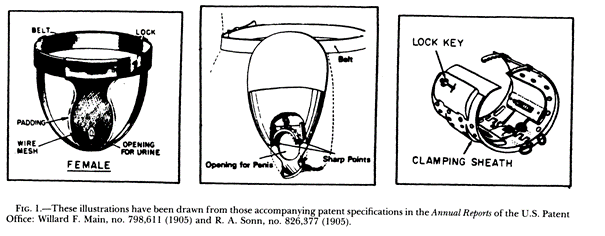
In conclusion, the chastity belt in the Boerhaave Museum tells a story about sexual health, fearmongering and control. If we look closer at the interpretation that for a long time has been given to the history of these devices, we discover how persistent myths about the past can be. The peak of the use of chastity belts was not during the Middle Ages when they were barely invented, but during the modern era. The main goal then was not to avoid adultery or rape but to prevent masturbation, specifically by young people.
Delphine Hanssens
Bibliography:
James A. Brundage. Review of Review of The Medieval Chastity Belt: A Myth-Making Process, by Albrecht Classen. Speculum 83, no. 2 (2008): 411–13.
Massimo Polidoro. Review of The myth of chastity belts, by Albrecht Classen. Skeptical Inquirer 35, no. 5 (1 September 2011): 27–29.
Rijksmuseum Boerhaave. ‘Collection Database: V03564’. Accessed 27 September 2021. https://boerhaave.adlibhosting.com/Details/collect/11418.
———. ‘Collection Database: V03565’. Accessed 27 September 2021. https://boerhaave.adlibhosting.com/Details/collect/11419.
Sexmuseum Amsterdam. ‘Timeline’. Accessed 27 September 2021. https://sexmuseumamsterdam.nl/timeline/.
Vern L. Bullough. ‘Technology for the Prevention of “Les Maladies Produites Par La Masturbation”’. Technology and Culture 28, no. 4 (1987): 828–32. https://doi.org/10.2307/3105184.
